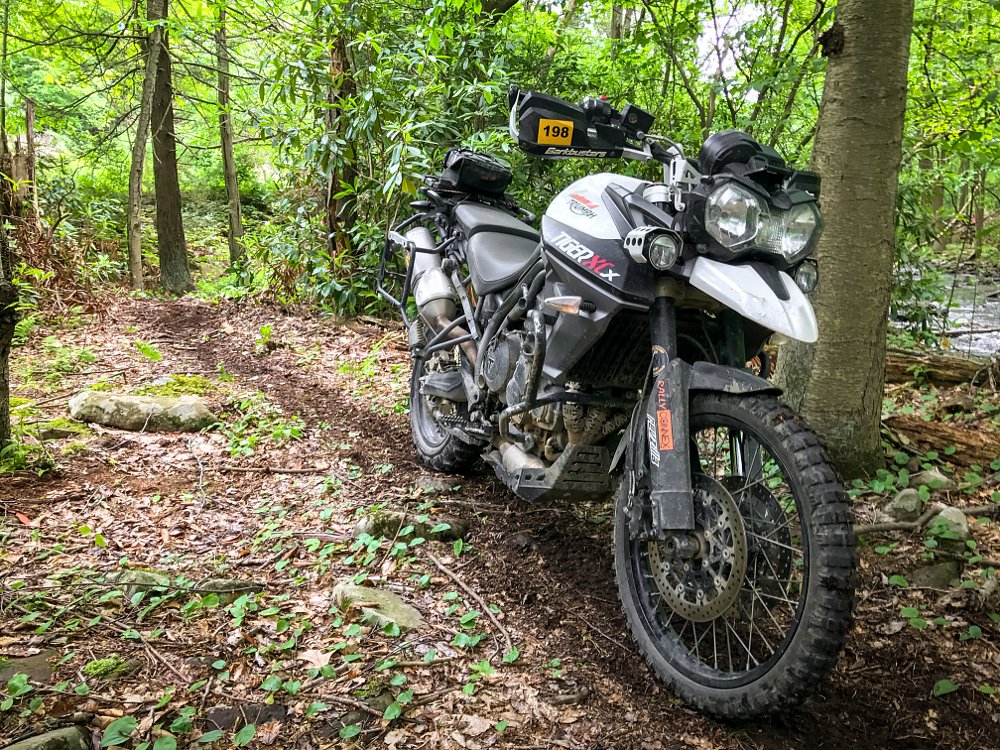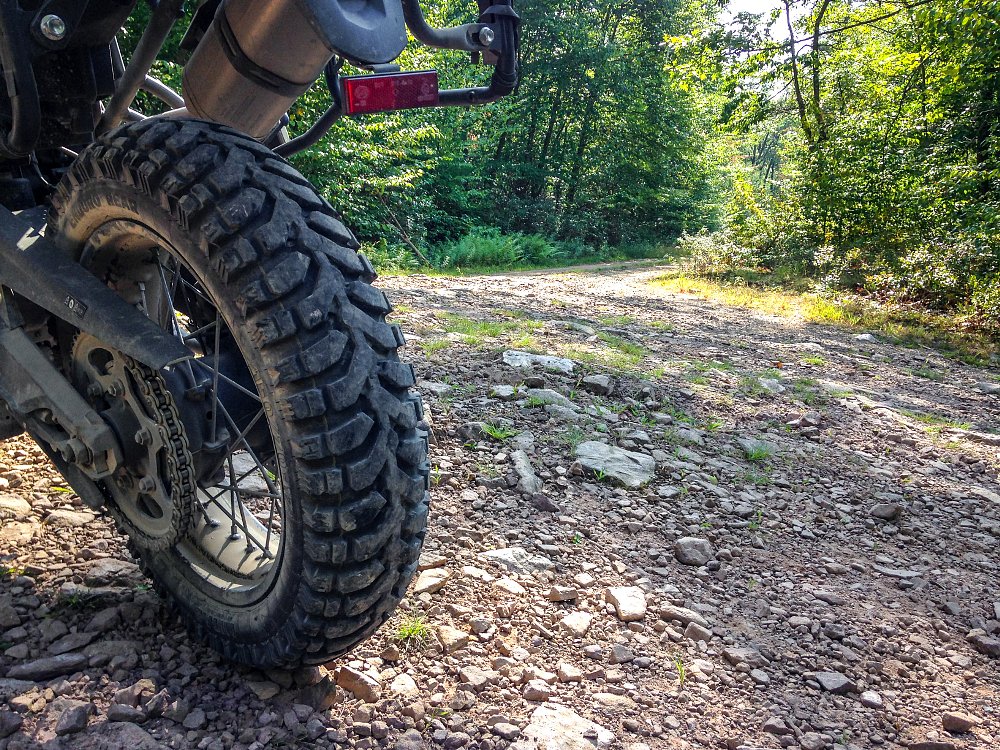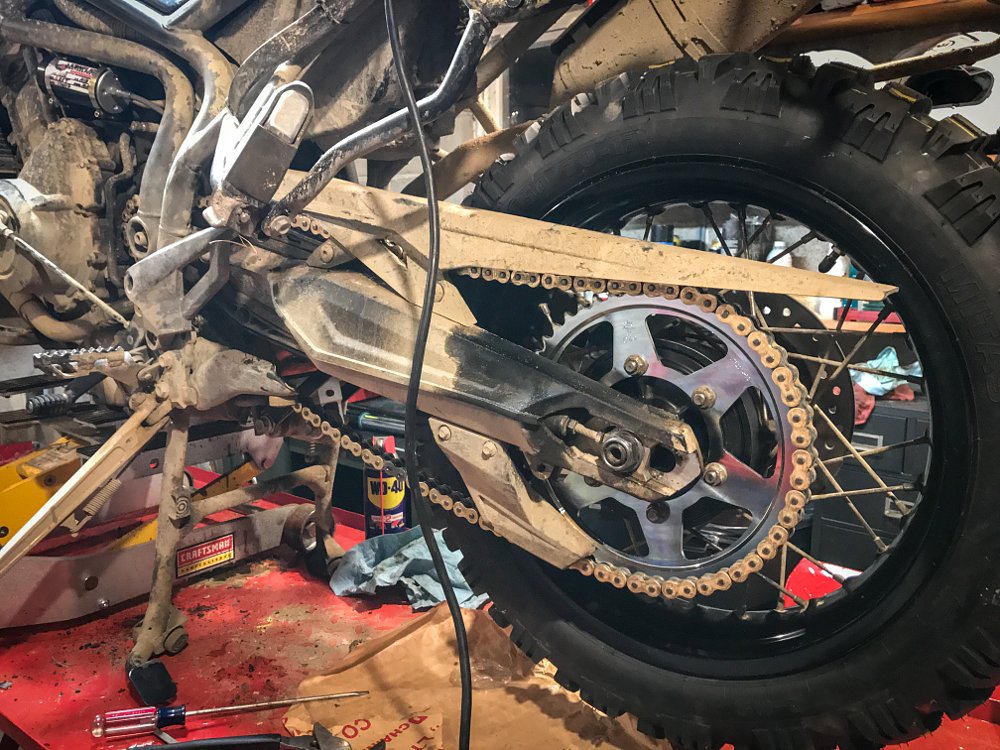Last year, I penned an article titled, “A year of the Tiger: Long-term abuse of a Triumph Tiger 800 XCx,” talking about my year of owning the bike and my plans for future modifications to focus more on off-road events. The comments section took off and quite a few folks showed interest in reading about additional modifications.
So now it's time to look at the changes I've made to make the Tiger even more capable in the dirt. While this article will discuss the modifications made to the Tiger, in reality, they can carry over to nearly any adventure bike, if your goal is better performance for riding off-road.

Modifying an expensive machine
No matter how expensive a motorcycle is, it’s designed to be a compromise. It has to work for tall and short riders, beanpoles and potbellies, as well as solo excursions and two-up treks. Some riders will abuse them off-road, some will ride them around the world and others are lucky just to make it around the block on weekends.

Because of this, manufacturers are constantly trying to find a balance between performance, protection, and price. If 80 percent of the consumer base is going to stick to the pavement, does it make sense to drive up final cost by adding a bunch of beefy protection?
Triumph, for example, addresses this compromise by offering no less than seven different configurations in the 2017 Tiger 800 family. But even with that level of purpose-driven design, most will still find the need to make modifications better suited to the kind of riding they plan to do.

Revisit the original article to see the first modifications I made, which focused on adding crash protection, upgrading the onboard tool kit and beginning to experiment with tires. Since then, I've continued to try different tires to get better off-road grip and performance.

Tires
Over the past year I have used Mitas E-07s, Continental TKC80s, and Mitas E-09s, which are currently installed on the bike.
So far I think the E-09 tires have been my favorite off-road. They maximize grip and offer predictable feedback. The stiffer sidewall found on the Dakar version helps to reduce the possibility of a flat tire. But because of the stiffer sidewall, the tire feels a bit unpredictable if you drop tire pressure too low. I found the happy middle ground to be around 25 psi in the front and 27 psi in the rear for off-road use. Regardless of pressure, these tires will try to kill you on the street. If it’s raining, don’t even bother with asphalt, just kick your bike over and walk away.

What the TKC80s give up to the E-09s in off-road grip, they make up for in street performance. These are probably the best all-around option for riders who want to ride further off-road but still want to feel comfortable on the street (“comfortable” being a relative term in relation to other knobby tires). I got about 2,200 miles out of the rear on the Tiger. While I am digging the E-09s a bit better off-road, I understand why the TKC80 tires have become a favorite for riders looking to take big bikes off-road while still relying on the pavement to get there.

I thought the E-07s were the best 50/50 option. These tires are the best alternative for the most riders. I got almost 7,000 miles out of a pair and there were probably a few thousand miles left to go when I replaced them. They offer a great blend of street performance and off-road capability. While they don’t grip as well in the sand or mud, I would say they are a good starting point for riders new to off-road ADV riding.
Tires will always be a compromise between grip and handling off-road and performance and longevity on-road. It’s up to you to be honest with yourself about how much time you’re really spending in the dirt and to chose a tire that matches your riding style.
Learning the limitations of your bike’s suspension
When I first rode the Tiger, I praised the WP suspension, but as time wore on and I tackled increasingly rough terrain, it began to show its limitations. I found myself relying on the skid plate with increasing frequency because the suspension wasn’t suspending the bike.
Keep in mind that the majority of motorcycles sold in this segment are sprung for 160- and 170-pound riders. Currently, I tip the scales at 215 pounds sans gear and nearly 240 when I’m decked out. The Tiger, much like a lot of stock bikes, needed suspension help.

Rather than buy all new components I opted to have the existing WP suspension modified. For that, I reached out to Konflict Motorsports in Washington state. Alex at Konflict discussed questions regarding my height, weight, and riding style to get a better idea of the desired upgrades. When I asked why he needed my height, he explained that the human head can weight almost 15 pounds (with a helmet) and riders over six feet tall leverage their weight differently than their shorter counterparts. Therefore, we tall folks need special considerations during setup.

Alex explained that the WP setup on the Tiger was similar to that of the KTM 1190 Adventure R, a bike he is constantly building new suspensions for. While there are some internal differences on the Triumph’s setup that presented some issues, Konflict was able to install heavier shock and fork springs and rework the internal valving. When things were all said and done, I ended up with a completely custom suspension, tuned for my weight and riding style, for around $1,100 (it would have cost me about that much to buy a replacement rear shock and it still wouldn’t have been tuned for me).
Getting to the final product, however, was the perfect storm of problems. Alex was in the middle of changing shop locations during the time I sent him my suspension and he had trouble sourcing the needed springs for my rebuild due to an issue with the spring manufacturer. Upon receiving it back the first time, one of the fork tubes was damaged and the rear shock was wearing the wrong spring. To his credit, Alex apologized, paid to have it shipped back, and replaced all of the damaged items. In the end the process from start to finish took a little over three months.
Was it worth it? The result was night and day over the stock setup. This was easily the top performance upgrade I performed on the Tiger. Where I used to have the preload on the rear maxed out, I am currently running the bike without a click of preload. I used to use up half the bike's stroke while just sitting still and now I have gained back much more of the eight or so inches of travel. Damping is much more sorted and the bike feels more responsive and planted over varying terrains. I am extremely pleased with the final result.

To anyone considering shipping your suspension off for modification, I would recommend being very clear on the expected timeline, make sure to insure any shipped items, and plan to have the work completed over the winter months when you won’t need your bike for a while. Luckily, I had a list of additional modifications and repairs I wanted to tackle. So while the suspension was off on vacation in Washington for a few months, I set about chipping away at a very long to-do list.
The clutch
The 2016 Pine Barrens 500 ride featured extremely deep sand. There had been little rain leading up to the event and by the end of the second day I had fried my clutch trying to complete the course. I was able to make it home, but it was clear the clutch needed to be replaced. There were 17,000 hard miles on the bike.
I ended up going with a clutch kit from Barnett. The kit included new fibers and steels, as well as springs, for around $200. This was less than half the price of the factory Triumph option, which didn’t include new springs.

Installation was super simple and the hardest part of the job was scraping all of the old gasket material off the cases. It made me realize how easy it would have been to make this repair on the side of the trail had I needed to in a rally situation. The main note I had for next time was to make sure the anti-judder spring, which sits behind the clutch plates, gets reinstalled correctly.

The Barnett requires more muscle at the lever due to the slightly stiffer springs, but it seems to offer more bite than the factory option. The real story, however, is the cost savings over the OEM replacement. I also like how easy their website is to use, they have friendly customer service, and they have a variety of fitments for many different makes and models
Gearing
Second to the suspension, changing the gearing yielded the most noticeable changes in the Tiger’s performance. Per a recommendation from my fellow Tiger aficionado Steve Kamrad, I decided to drop two teeth on the countersprocket, which is nearly the same as going up six teeth in the rear.

This makes a drastic change in the bike's performance. It is much easier for the bike to pull out of tight, technical terrain in first gear. In second and third gears, it really wakes up, feeling like a completely new machine. The only downside is that if you want to run on the highway the engine is now going to be spinning extremely fast in sixth gear and your maximum speed will barely crest triple digits before reaching the redline.
The beauty of changing the countershaft sprocket, however, is that I can swap it back to stock gearing without having to cut the chain. I ended up ordering two different countershaft sprockets as well as a stock rear for this purpose. The folks at Sprocket Center had everything I was looking for in multiple configurations.
While this is a modification that can benefit most of today's ADV machines in an off-road setting (unless you’re rocking a shaft drive), I wouldn’t recommend it if you are regularly riding long distances on the highway, unless you’re planning on continually swapping sprockets.
A steering damper
Talking with some fellow riders at this year’s Pine Barrens 500, a few of them recommended the addition of a steering damper for more stability at high speeds in the soft sand. A local Tiger owner showed me a GPR kit he had fitted to his bike. The cool thing about the GPR kit is that it comes with not only a stabilizer and mount, but also with a handlebar riser kit.

As RevZilla only carries GPR's sport stabilizers, I had to order directly from GPR for this one. Their sales staff was extremely helpful and the installation instructions couldn’t have been clearer.
Riding in the deep sand of the Pine Barrens was much smoother. I didn’t have the front wheel wanting to kick out or buckle nearly as badly when landing jumps. The one thing to note here is that even the "zero" setting goes a long way. I wish there was a true bypass that allowed for no damping at slow speeds, but I found it really easy to just loosen the two mounting bolts and pull the damper off when I didn’t want it in low-speed, technical terrain, and throw it back on when things started speeding up.
Air pre-filter
If you’ve ever had to change the air filter on a Tiger, you know it can be a pain in the ass. That’s not a huge inconvenience if you only have to tackle that job every 12,000 miles, as the owner’s manual suggests. However, if you’re regularly riding off-road, you should check and replace that filter much more frequently.

Less than 3,000 miles after installing a reusable K&N air filter, I pulled the tank to see how she was looking. I was alarmed by the amount of dirt and dust that had the filter almost completely clogged. In an effort to prevent this from happening again, I installed a Uni Air Pre-Filter kit, which replaces the factory airbox snorkel with an oiled sponge filter. So far, it has worked great and is much easier to access and clean than the main filter.

Rear brake control
One of the simplest additions to the Tiger that I made was AltRider’s Dual Control Brake system. It allows for better reach to the brake lever when standing as well as sitting. It mounts on top of the bike's existing brake pedal and provides noticeably better feedback.

The one downside that I have found with this product is that the larger foot platform increases the susceptibility of the rear brake pedal to bend under pressure, such as tip-overs and low-side crashes.
Odds and ends
In addition to the larger modifications, I did a slew of regular maintenance. I upgraded all of the brake pads to EBCs when the stock ones wore out. With the wheels and suspension removed, I used it as an opportunity to install tapered steering head bearings and new wheel bearings from All Balls Racing. And I gave everything a good cleaning, torquing and tightening bolts along the way.

Final thoughts
A lot of what I learned while living with the Tiger became the foundation for our ADV Modifications video. There are so many places to start, it can almost seem overwhelming at first.
If you are operating on a limited budget and you can only invest in one modification, invest in yourself. More than anything I’ve added to the bike, off-road rider education has proved to be invaluable. Getting a basic understanding of body positioning and learning to be comfortable standing on the bike while it slips and slides underneath you is key. These large, heavy machines are much more fun to ride once you understand how they work.

What is the next modification I plan on making to the Tiger? Depends on what I break next.




















